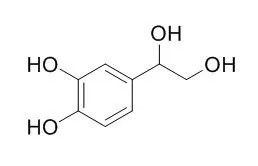| In vitro: |
| J Clin Pharmacol. 2015 May 22. | | Pharmacodynamics of norepinephrine reuptake inhibition: Modeling the peripheral and central effects of atomoxetine, duloxetine, and edivoxetine on the biomarker 3,4-dihydroxyphenylglycol in humans.[Pubmed: 26011686] |
Norepinephrine, a neurotransmitter in the autonomic sympathetic nervous system, is deaminated by monoamine oxidase to 3,4-Dihydroxyphenylglycol (DHPG).
METHODS AND RESULTS:
An indirect response model was used to describe the relationship between drug plasma concentration and DHPG concentration in plasma and CSF. The baseline plasma 3,4-Dihydroxyphenylglycol concentration (1130-1240 ng/mL) and Imax (33-37%) was similar for the 3 drugs. The unbound plasma drug IC50 (IC50U ) based on plasma 3,4-Dihydroxyphenylglycol was 0.973 nM for duloxetine, 0.136 nM for atomoxetine and 0.041 nM for edivoxetine. The baseline CSF 3,4-Dihydroxyphenylglycol concentration (1850-2260 ng/mL) was similar for the 3 drugs, but unlike plasma 3,4-Dihydroxyphenylglycol, the Imax for 3,4-Dihydroxyphenylglycol was 38% for duloxetine, 53% for atomoxetine and 75% for edivoxetine. The IC50U based on CSF 3,4-Dihydroxyphenylglycol was 2.72 nM for atomoxetine, 1.22 nM for duloxetine and 0.794 nM for edivoxetine.
CONCLUSIONS:
These modeling results provide insights into the pharmacology of NET inhibitors and the use of DHPG as a biomarker. | | J Agric Food Chem. 2015 Jan 28;63(3):836-46. | | Naturally occurring hydroxytyrosol derivatives: hydroxytyrosyl acetate and 3,4-dihydroxyphenylglycol modulate inflammatory response in murine peritoneal macrophages. Potential utility as new dietary supplements.[Pubmed: 25526103 ] |
METHODS AND RESULTS:
This work evaluated the effects of extra virgin olive oil (EVOO) phenols, hydroxytyrosyl acetate (2) and 3,4-Dihydroxyphenylglycol (3), as well as two new acyl derivatives of 3, 4-(1,2-di(butanoyloxy)ethyl)benzene-1,2-diol (7) and 4-(1,2-di(lauroyloxy)ethyl)benzene-1,2-diol (8), on LPS-stimulated murine peritoneal macrophages in comparison with hydroxytyrosol (HTy, 1). Compounds 2, 3, 7, and 8 showed a strong reactive oxygen species (ROS)-scavenging activity, reducing significantly nitrite levels with a significant decrease on iNOS expression [2 (50 μM, 0.44 ± 0.03; 100 μM, 0.44 ± 0.01; p < 0.01); 3 (50 μM, 0.37 ± 0.03; 100 μM, 0.37 ± 0.01; p < 0.001); 7 (50 μM, 0.45 ± 0.06; p < 0.01)] . However, only 2 and 3 down-regulated COX-2 expression [2 (50 μM, 0.72 ± 0.04, p < 0.05; 100 μM, 0.54 ± 0.06, p < 0.01); 3 (50 μM, 0.56 ± 0.05, p < 0.05; 100 μM, 0.37 ± 0.04; p < 0.001)] and prevented IKBα degradation [2 (100 μM, 1.63 ± 0.14, p < 0.01); 3 (100 μM, 1.82 ± 0.09; p < 0.01)] ; the diacylated compounds 7 and 8 showed worse anti-inflammatory activity than the parent 3. In conclusion, 2 and 3 phenolic derivatives could play an important role in the anti-inflammatory effect of EVOO.
CONCLUSIONS:
The implication of this study for the nutrition and general health of the population rests in the possible use of natural HTy derivatives with better hydrophilic/lipophilic balance, thus improving its pharmacodynamic and pharmacokinetic profiles, as new dietary supplements in foods. |
|
| In vivo: |
| Mol Nutr Food Res. 2012 Jul;56(7):1137-47. | | Alperujo extract, hydroxytyrosol, and 3,4-dihydroxyphenylglycol are bioavailable and have antioxidant properties in vitamin E-deficient rats--a proteomics and network analysis approach.[Pubmed: 22648667 ] | Olive products are rich in phenolic compounds, which are natural antioxidants in vitro. We tested the in vivo effects of alperujo, an olive production by-product, as well as hydroxytyrosol and 3,4-Dihydroxyphenylglycol (DHPG) isolated from alperujo, on indices and pathways of oxidative and metabolic stress in a vitamin E-deficient rat model.
METHODS AND RESULTS:
Rats were fed a vitamin E-deficient diet for 10 weeks, followed by this diet supplemented with either 100 mg/kg diet dα-tocopherol, alperujo extract, hydroxytyrosol, or 10 mg/kg diet DHPG, for a further 2 weeks. We detected alperujo phenolics in tissues and blood, indicating they are bioavailable. Alperujo extract partially ameliorated elevated plasma levels of thiobarbituric acid reactive substances and also lowered plasma cholesterol levels, whereas hydroxytyrosol increased plasma triglyceride levels. Proteomics and subsequent network analysis revealed that hepatic mitochondrial aldehyde dehydrogenase (ALDH2), of which protein and activity levels were regulated by dα-tocopherol and olive phenolics, represents a novel central regulatory protein hub affected by the dietary interventions.
CONCLUSIONS:
The in vivo free radical scavenging properties of olive phenolics appear relatively modest in our model. But alternative mechanisms, including regulation of ALDH2, may represent relevant antioxidant mechanisms by which dietary olive phenolics could have beneficial impact on cardiovascular health. | | Life Sci. 1991;49(1):75-84. | | Plasma 3,4-dihydroxyphenylglycol (DHPG) and 3-methoxy-4-hydroxyphenylglycol (MHPG) are insensitive indicators of alpha 2-adrenoceptor mediated regulation of norepinephrine release in healthy human volunteers.[Pubmed: 1646924] |
METHODS AND RESULTS:
The usefulness of the plasma concentrations of two major metabolites of norepinephrine (NE), 3,4-Dihydroxyphenylglycol (DHPG) and 3-methoxy-4-hydroxyphenylglycol (MHPG), as indicators of neuronal NE release was investigated. The potent alpha 2-adrenoceptor agonist, dexmedetomidine, induced only about 15% maximal reductions in the metabolite concentrations, in spite of almost total inhibition of neuronal NE release, as evidenced by 90% reductions in plasma NE concentrations. Similarly, administration of the alpha 2-adrenoceptor antagonist atipamezole was followed by only small increases in plasma DHPG and no change in MHPG levels, in spite of almost six-fold, albeit short-lasting, increases in plasma NE. In contrast, a single dose of the reversible monoamine oxidase type A (MAO-A) inhibitor moclobemide reduced plasma DHPG levels by 78% and MHPG levels by 51%.
CONCLUSIONS:
It is concluded that the plasma concentrations of DHPG and MHPG are largely determined by intraneuronal, MAO-A-dependent metabolism of NE, and do not accurately reflect acute alterations in neuronal NE release. The concentration of NE in venous plasma is clearly a more sensitive indicator of alpha 2-adrenoceptor-mediated regulation of NE release. |
|






 Cell. 2018 Jan 11;172(1-2):249-261.e12. doi: 10.1016/j.cell.2017.12.019.IF=36.216(2019)
Cell. 2018 Jan 11;172(1-2):249-261.e12. doi: 10.1016/j.cell.2017.12.019.IF=36.216(2019) Cell Metab. 2020 Mar 3;31(3):534-548.e5. doi: 10.1016/j.cmet.2020.01.002.IF=22.415(2019)
Cell Metab. 2020 Mar 3;31(3):534-548.e5. doi: 10.1016/j.cmet.2020.01.002.IF=22.415(2019) Mol Cell. 2017 Nov 16;68(4):673-685.e6. doi: 10.1016/j.molcel.2017.10.022.IF=14.548(2019)
Mol Cell. 2017 Nov 16;68(4):673-685.e6. doi: 10.1016/j.molcel.2017.10.022.IF=14.548(2019)